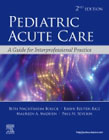
Pediatric Acute Care: A Guide to Interprofessional Practice
Bolick, Beth Nachtsheim
Reuter-Rice, Karin
Madden, Maureen A.
Severin, Paul N.
Stay up-to-date on the latest evidence and clinical practice in pediatric acute care with the definitive textbook in the field. Now in its second edition, Pediatric Acute Care: A Guide for Interprofessional Practice takes an evidence-based, interprofessional approach to pediatric acute care as it exemplifies the depth and diversity that's needed for the dynamic healthcare environments in which acutely ill children receive care. Coverage includes how to work with the pediatric patient and family, major acute care disorders and their management, emergency preparedness, common acute care procedures, and much more. With contributions from more than 200 practicing clinicians and academic experts, it represents a wide variety of disciplines including medicine, nursing, pharmacy, child life, nutrition, law, integrative medicine, education, public health, and psychology, among others. The second edition also features the addition of new physician and nurse practitioner co-editors as well as extensive content updates including updated evidence-based content throughout the text, the integration of the 2016 IPEC Core Competencies for Interprofessional Collaborative Practice, a new full-color design, and new vivid illustrations throughout. INDICE: Part I. Interprofessional Patient Care 1. The Interprofessional Team 2. Research and Evidence-Based Practice 3. Certification, Licensure, and Credentialing/Privileging 4. Documentation and Coding 5. Team Communication and Handoffs 6. Patient Safety Part II. Approach to the Pediatric Patient and Family 7. Child Life: Developmental Considerations 8. Patient and Family-Centered Care 9. Communicating Bad News 10. Ethical Considerations 11. Care of the Minor and Legal Implications 12. Transition to Adulthood 13. Care of Children with Medical Complexity 14. Management in the Emergency Setting 15. Management in the Inpatient Setting 16. The Premature Infant in the Pediatric Acute Care Setting 17. Management of the Chronically Critically Ill 18. Transport of the Ill or Injured Pediatric Patient 19. Rehabilitation 20. Palliative Care and Integrative Medicine Part III. Selected Disorders and Their Management 21. Analgesia, Paralytics, Sedation, Withdrawal, and Opioid Disorders 22. Cardiac Disorders 23. Dermatologic Disorders 24. Endocrine Disorders 25. Fluid, Electrolytes, and Nutrition 26. Gastrointestinal Disorders 27. Genetic and Metabolic Disorders 28. Hematologic and Oncologic Disorders 29. Immunologic/Autoimmune and Rheumatologic Disorders 30. Infectious Disorders 31. Kidney and Genitourinary Disorders 32. Musculoskeletal Disorders 33. Neurologic Disorders 34. Orofacial Disorders 35. Pulmonary Disorders 36. Child Maltreatment 37. Toxicologic Exposures 38. Traumatic Injuries Part IV. Emergency Preparedness 39. Principles of Disaster Management and Clinical Practice Part V. Procedures 40. Arterial Catheter Insertion 41. Central Venous Catheter Insertion and Removal 42. Chest Tube Insertion and Removal 43. Intracardiac Line Removal 44. Intraventricular Catheter Insertion and Shunt Access 45. Lumbar Puncture 46. Postpyloric Feeding Tube Insertion 47. Peripherally Inserted Central Venous Catheter (PICC) Insertion and Removal 48. Peritoneal Catheter Insertion 49. Rapid-Sequence Intubation 50. Ultrasound Guidance 51. Wound Closure Part VI. Lab Values 52. Laboratory Values Part VII. Learning and Evaluation 53. Simulation 54. The Role of Assessment in Teaching and Learning Index
- ISBN: 978-0-323-67332-7
- Editorial: Elsevier
- Encuadernacion: Rústica
- Páginas: 1408
- Fecha Publicación: 12/08/2020
- Nº Volúmenes: 1
- Idioma: Inglés
